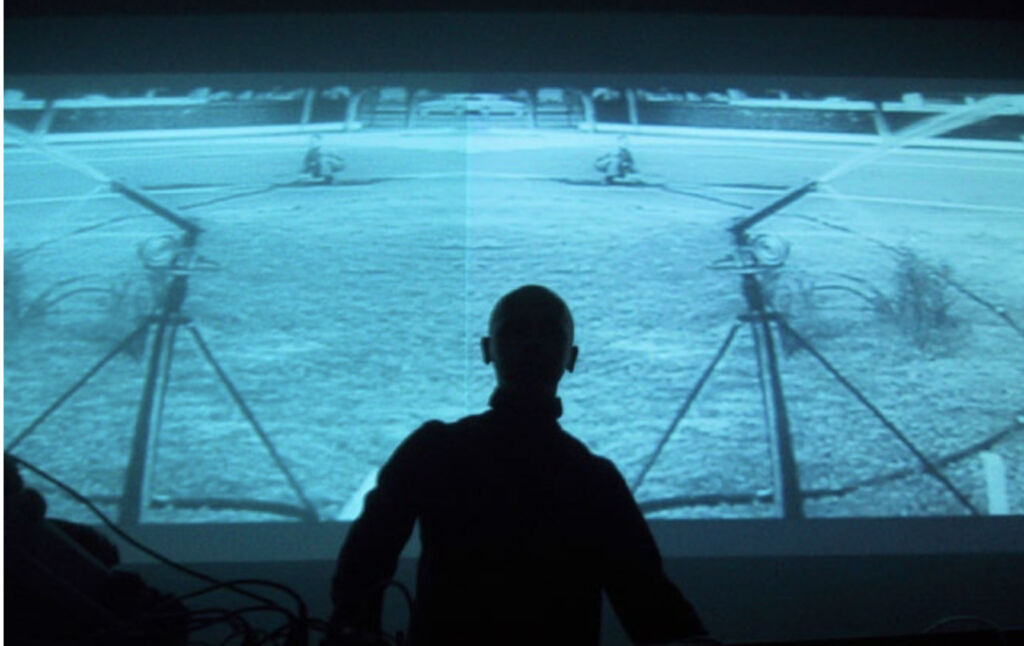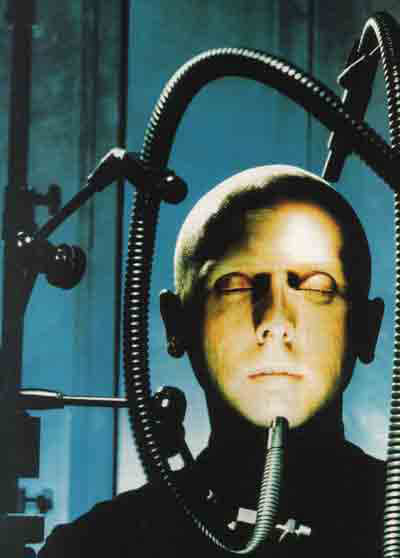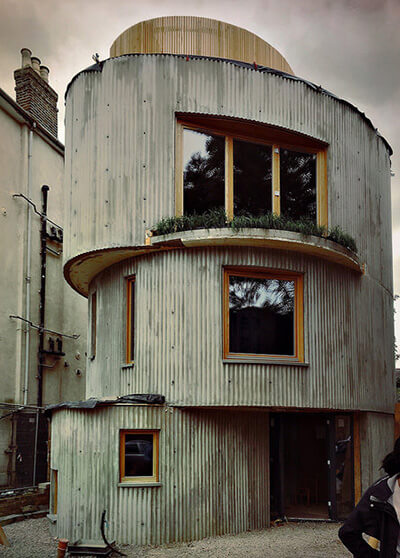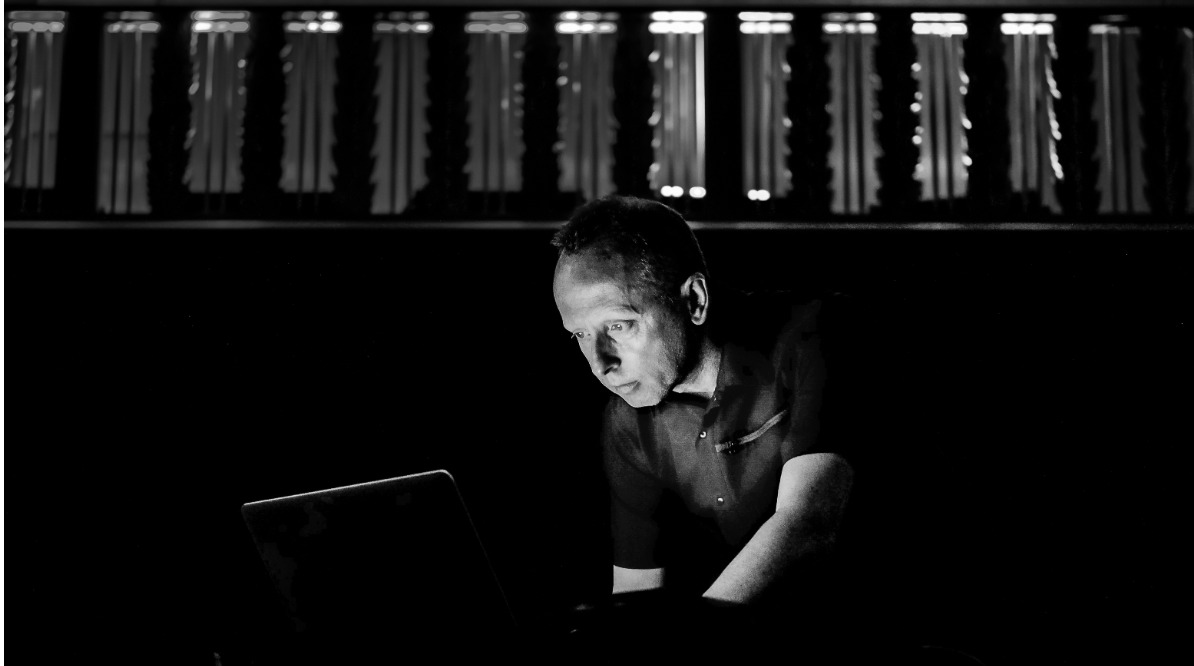Interview by Meritxell Rosell

In The dreamer is still sleep – one of the latest artworks of Robin Rimbaud (aka Scanner)- the British artist explores the dreamy state between sleeping and waking with sounds and smells. The piece is a sound and aromatic installation commissioned by SHIFT and the National Trust for Little Moreton Hall, a Tudor building outside Congleton (Cheshire).
Rimbaud has created a sonic experience where voices, music, footsteps and glasses clinking bring about an atmospheric and cinematic experience, aiming to transport us to what the place might have been centuries ago. Coincidentally or not, taking the name of one of Coil’s songs, the piece is an inner journey through layers of impressions in time, connecting the viewers to the ‘spirit of place’.
The dreamer is still asleep and also reflects on how different places and locations make us feel and behave; and the other way around; what is the impact of human existence in the places we inhabit? These situationist concepts are quite central in Rimbaud’s extensive body of work. Situationist International was a mid-20th-century avant-garde international organisation of artists, political theorists, writers and poets who aimed to break down the barriers between culture and everyday life, emphasizing concepts such as unitary urbanism and psychogeography.
As a sort of situationist entangled in the 21st century, Rimbaud has spent the last 25 years exploring these time-space-emotion relationships incorporating technology into the equation, bringing about invisible or overlooked aspects of our world.
Scanner’s early musical experiments incorporated snippets taken from random telephone conversations recorded with a police scanner (hence the name) in what some have called a form of audio-voyeurism and challenging concepts of public and private places. But what started as a fascination with radio waves, mobile phone signals, and police scanners evolved into numerous interdisciplinary projects, developing an interest in the production of site-specific sound and expansion of the terrain between sound, space image and form.
Albums such as Mass Observation (1994), Delivery (1997) and The Garden is Full of Metal (1998) have been praised as innovative works of contemporary electronic music. His most recent, The Great Crater (2017), takes inspiration from strange circles appearing in Antarctica. Drilling into the ice, scientists found various lakes beneath the surface, which brought concerns about further disintegration. The album is an exploration of this fragile environment stretching the limits of sound and manipulation.
Aside from his own music productions, Rimbaud, throughout his career, has worked with numerous cutting-edge practitioners. He has collaborated with dance companies and choreographer Wayne MacGregor (Qualia (2004), a commission by the Royal Opera House), with fashion designer Hussein Chalayan (composing the music for his 2012 Paris collection) and a morgue in Paris (Salles Des Départs (2001)). Musical collaborators have included Mike Kelley (Esprits de Paris, 2001, a sound project on ghosts and haunted Paris locations for the Pompidou Centre), Carsten Nicolai (Alva Noto), Brian Ferry, Laurie Anderson and Wire’s Colin Newman. More recently, we’ve seen him working with Gazelle Twin and the Haxan Cloak.
A most recent collaboration, Vex (2017), brought together Rimbaud with Stephen Chance and Wendy de Silva, an architectural duo based in London, known for collaborating with a diverse set of artists from other disciplines, such as dancers and photographers. Vex, an architectural (house) design, is inspired by Vexations (1893), an infamous composition by Erik Satie in which a page-long piano figure is repeated 840 times and was not published within his lifetime. Scanner was commissioned to compose a piece inspired by the house and Satie’s Vexations that could be played in the house once complete.
The sense of the relevance of the role of places and locations and the resonance of those who once inhabited them unveils prominently apparent throughout the artist’s prolific body of work. In Rimbaud is cities like Paris or London, haunted houses, hospitals, cemeteries or more abstract ideas of private and public spaces. With hauntological creative projections, Rimbau’s able to make us look straight into the future infused with the past contained in our present.


You are an experimental music composer and artist with work exploring sound, space and image. With a long trajectory, as since 1991, you’ve been intensely producing sonic art, concerts, installations and recordings. There is also a prominent twist on technology in unconventional ways in your practice (your professional name, Scanner, actually comes from your use of police scanners in live performances). For those that are not familiar with your work, could you tell us how and when did the interest in sound and technology come about?
I’ve been recording since I was around 10 or 11 years old. We had a cheap 1970s tape recorder at home, and I used to record TV shows like Spiderman on it so I could listen to them later on, as VHS tape recorders had yet to be invented! Then I realised I could record our birthdays, holidays, Christmas time, trips on the school bus, etc.
Rather like the way people use their smartphones today to photograph all the time, the tape recorder offered me a way to record the world around me, without any ambitions of using it in any other way, but just because it was there and accessible and fun to do!
In fact, I still have those cassette tapes and spent last summer digitising everything, so it was like a form of time travel, hearing voices, conversations, and the sounds of my old family living room that I’d not heard since that time. With all my family now deceased, it was also an extraordinarily moving experience living through those ghosts. It’s incredible what images they can present to me, far more than photos in some ways, as you can actually hear the physical space.
As for the scanner device itself, it was purely by chance that I discovered it since a friend was part of a hunt saboteur group, and they would use it to listen in to the local police. I immediately saw the potential and intrigue of being able to access these private spaces and incorporate them into the exploratory soundscapes I was producing at the time. I was especially drawn to the fact that the recordings were so intimate and clear yet abstract. One had to imagine who these people were over overhearing, where they were, and what kinds of lives they led, although the nature of their conversations often clearly explained this!
So I began using these live voices and recordings inside the music I was producing and adopted the name of the machine I was using to create the work, so in some ways not that far from where I first began at home recording the family and school friends.
How have you evolved or adapted the technological aspects of your practice alongside your -more than 20 years expanding- career?
In many ways, my life’s work has been born from a series of chance encounters and discoveries in technology. I was born in the 1960s, so growing up in the 1970s offered a different approach to life than it does today. Technology was not as abundant then as it is today; the very idea of being able to maintain a relationship with the world further than your close friends and family was an impossible fantasy and could only be achieved by finding a pen pal on the other side of the globe to communicate with. Today at the swish of a thumb, we can meet people, make sounds, and discover new worlds.
I’ve always been drawn towards new technologies. Back in the late 1980s and early 1990s I was using bulletin boards, a precursor to what we now recognise as the Internet, and was one of the first people in my peer group to have email back then. So I use the tools of my time to create work that reflects the times and my ideas as they develop. Having said that, it’s important to maintain a voice that reflects who you are, whether it’s with words, sounds or images.
It was about possibilities, and to this day, my work and explorations with technology follow a similar enthusiastic route. What if…is a question that frequently raises its head during sessions and engagements with commissions? The technology enabled this process to begin for me. It’s rather like the camera on a mobile phone. I doubt very much whether many of the people documenting every droll moment of their lives would necessarily photograph it were it not for the fact that it’s simply accessible and possible.
Throughout your extensive body of work, there’s a strong sense of the importance that places, locations and the people who inhabit them have imprinted on your pieces (locations in cities like Paris or London, haunted houses, hospitals, cemeteries and even in your Self-titled record (1993) you reflect on the concept of public and private places). Is psychogeography a current that has influenced your practice, and if so, how?
Psychogeography has always fascinated me, and a glance through my book collection will show a wealth of books on Situationism, the writings of British author Iain Sinclair and other books exploring the role of the flaneur, the solitary figure wandering the landscape, exploring without intent. The role of place and the resonance of those who once inhabited spaces inform many of the projects I develop, capturing and exploring locations I’m not familiar with. Concepts of myth, memory and landscape always appeal to me!
Your latest sound installation, ‘The Dreamer is still asleep’ at the National Trust property Little Moreton Hall in Cheshire, is a sound and aromatic installation that explores the transcendent state between sleeping and waking with sounds that would once have filled the hall. Could you tell us about the intellectual process behind it?
My work frequently celebrates forgotten, invisible and overlooked aspects of the world we inhabit. The Dreamer is Still Asleep is an ode to history and an astonishing building, enhancing visitors’ experience by stimulating their imaginations.
I was aware that the National Trust was working with Trust New Art to develop works that combined historic spaces with original works of art that focused on the senses, in particular sight, sound and smell. My installation accompanies a new programme, ‘How We Used to Sleep’, and I wanted the work to celebrate the ghosts of the past in the present, embracing both the cultural and the historical in a playful and engaging manner.
The context was everything, to encourage visitors to explore a part of the building they would not perhaps ordinarily invest as much time in, but also to encourage them to stop and listen and travel through time in sound and smell.
The sound attempts to conjure up a sense of the past by taking the listener on an imaginary trip through these times. Voices are heard, laughter, music and the presence of others in the space but never seen. It’s removed from the more traditional recreation of the sound of a pastime as in many museum installations, offering something more artful, creative, playful and abstract. In addition, the use of scent in the space adds an additional element to the experience, transporting the spectator in their imagination.
You’ve collaborated with artists and creators like Mike Kelley, Carsten Nicolai, Laurie Anderson and Hussein Chalayan, and so many others. Which has been the most influential of these collaborations?
I am a consistent collaborator in all fields, frequently with artists quite outside of the field of music, and it would be impossible to choose one over another! Whether it’s a writer, an artist, a video maker, a choreographer or an architect, the ability to exchange and share ideas is crucial, and these collaborations allow me and the collaborator to work as both negatives and positives of each other, recognising spaces within the work fields and ideas of the other. It teaches the respect of space but also the relevance of context and the extension of one’s ideas to the other. They will listen to you if you listen to them, how life should function in general.
In a time where we seem to be bombarded with challenging discoveries in artificial intelligence and their possible impact on artistic creativity, as a writer and media critic as well, what do you think about projects like Magenta, Google Brain’s initiative to develop tools that use machine learning to create compelling art and music?
In principle, the idea of machine generation music is fascinating, but from experience, any machines that bravely attempt to mimic the creative process leave me rather wanting. I’ve yet to experience any writing or art produced by a machine to offer any of the rewards or resonances that have been born from the mind of a human.
I’ve used generative systems within compositions to create work, and that has offered an insight into possibilities, but we are still some way off from capturing anything truly memorable or remarkable.
Indeed there are a number of companies who now produce automated customised music for commercial advertising and film, and their rather bland and dull character of them certainly doesn’t appeal to my generous ears.
What is your chief enemy of creativity?
Administration mostly! Without a manager, record label, music publisher, or agent, every transaction passes through my office, and I deal directly with every transaction, interaction and communication. I’m still working on a cloning system so one of me can spend more time in the studio whilst the other one responds to everything else.
You couldn’t live without…
Electricity.






